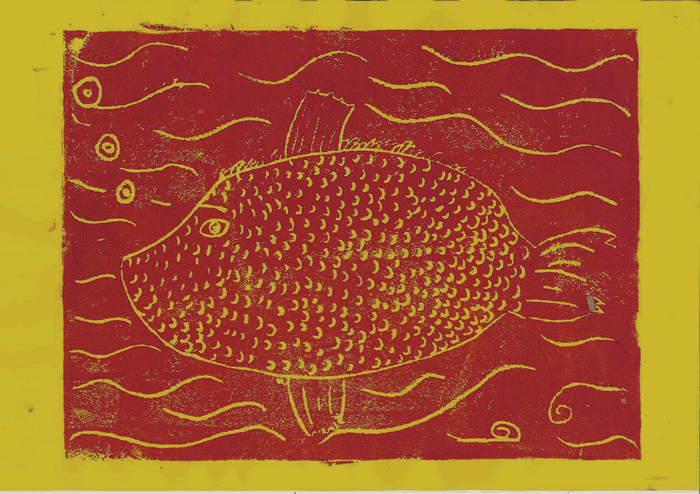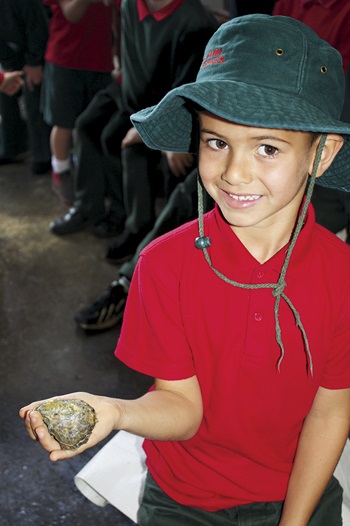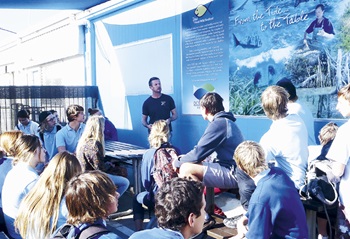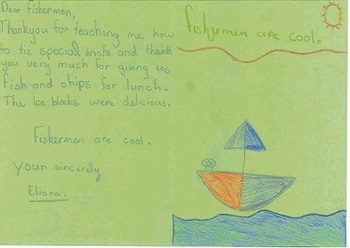An FRDC-funded program facilitating an introduction to the seafood industry for schoolchildren has provided benefits to schools and professional fishers alike
 Inspired by their visit with professional fishers Paul and Richie Bagnato at Sydney Fish Market, students from Glebe Public School in Sydney created fish-themed artworks on their return to the classroom.
Inspired by their visit with professional fishers Paul and Richie Bagnato at Sydney Fish Market, students from Glebe Public School in Sydney created fish-themed artworks on their return to the classroom. By Sarah Clarry
Many people have very little understanding of what is involved in bringing high-quality seafood into homes and restaurants. However, with funding from the FRDC, OceanWatch Australia has developed the Seafood Industry Partnerships in Schools (SIPS) program.
Through the program, the fishing industry has started a conversation with schoolchildren and teachers in New South Wales and Tasmania about some of the great work going on in the industry. SIPS involves real-world professional fishers and aquaculture farmers visiting schools, or hosting visits from students at their places of work.
 Mitchell, a student from Bobs Farm Public School, near Port Stephens in New South Wales, holds up an oyster during the school’s visit to XL Oysters at Lemon Tree Passage.
Mitchell, a student from Bobs Farm Public School, near Port Stephens in New South Wales, holds up an oyster during the school’s visit to XL Oysters at Lemon Tree Passage. The fishers and farmers talk to children about the steps required to bring seafood from the ocean or estuaries through to the table.
Through SIPS, more than 30 seafood industry partners have become involved with their local school communities.
While the project has been successful in raising awareness of the industry among those participating, it has also provided a platform for the fishers to showcase their work to an enthusiastic audience.
One participating fisher commented:
“I think the community needs to know that we care about the resource as much as we care about making a living. SIPS brings the community and fishermen together … it fits in the middle of that gap.”
An oyster farmer added, “It’s important to engage with the community, as they are waterway stakeholders. They need to be on-side and understand that the industry is environmentally conscious.”
Aims of SIPS
OceanWatch devised SIPS as a way to educate the broader community about the importance of the seafood industry and how it is being managed to ensure its future sustainability.
The program has three aims:
- to facilitate educational partnerships between schools and industry operators;
- to increase community understanding about the complexity of managing marine resources; and
- to increase the capacity for the seafood industry to tell its stories to the community.
Schools represent an ideal target audience for SIPS, because an overarching goal of the program is to change community attitudes towards a more positive, engaged view of the seafood industry.
Schoolchildren are often open-minded in their views and opinions, and their willingness to learn can have an influence on the attitudes and beliefs of friends and family.
The program aims to educate children about the life of professional fishers and their efforts to conserve the resources that they depend on for their livelihoods.
The SIPS Model
 Students from Great Lakes College, Forster Tuncurry, New South Wales, listen to a presentation during their visit to the Coffs Harbour Fishermen’s Co-operative.
Students from Great Lakes College, Forster Tuncurry, New South Wales, listen to a presentation during their visit to the Coffs Harbour Fishermen’s Co-operative. Photos: OceanWatch Australia
SIPS began in Tasmania in 2010 and its success there saw the program expanded into NSW in 2012. Tasmania was chosen as the pilot site because of the size and significance of its seafood industry and the proximity of so many facilities to participating schools.
NSW provided a different profile for OceanWatch. Its largely urban population is quite removed from the seafood industry, even when schools are located in fishing and aquaculture-farming areas.
School groups who signed up for SIPS were partnered with a seafood industry worker, such as a commercial fisher or an oyster farmer. Partnerships were tailored to suit the needs of the school and program partner, and included classroom visits, excursions (to a wharf, aquaculture facility, processing facility or seafood business) and ongoing contact between partners.
Every excursion offered something different to the students participating. In Tasmania, a primary-school class visited the Hobart docks with a rocklobster fisher and boarded a vessel before eating a seafood lunch, while a secondary-school class visited the Tassal salmon hatchery in the Huon Valley.
In NSW, one primary school on the mid-north coast visited an oyster farm, and another secondary school visited a fishermen’s co-op, where they held a Mud Crab and a large Mahi Mahi, and tasted seaweed.
Evaluation
 A thank-you note sent from a Glebe Public School student following a visit to Sydney Fish Market.
A thank-you note sent from a Glebe Public School student following a visit to Sydney Fish Market. The effectiveness, impact, appropriateness, efficiency and legacy of the program were all evaluated by OceanWatch and information compiled into a report, using feedback from teachers, students, industry personnel and the SIPS Steering Committee.
The majority of teachers rated the program as ‘Excellent’ or ‘Very good’. The hands-on activities, such as mending nets, holding a Mud Crab (tied up), looking over fishing vessels and handling seafood were the most popular.
Michelle Biles, a Marine Studies teacher from Shoalhaven High School in NSW, said: “The more hands-on experiential learning and community involvement, the more the students can see the relevance and importance of what they are learning.”
The teachers who were surveyed unanimously agreed that the SIPS activities in which they participated were an effective way for the seafood industry to engage with schools. “It’s obvious from personal interaction with the fishers that they talk and live sustainability,” one teacher said.
The professional fishers involved also appreciated the opportunity the program provided to improve the image of the industry and demonstrate the pride with which they do their jobs.
“Showing kids what we do … they can have a positive outlook on industry. SIPS gives them that kickstart,” one industry partner said. “So in the future, when that negativity comes to them, they can say: ‘One second, I’ve met that fisher, and I know the reason he is out there catching fish. He’s not only making a living for himself, he’s looking after the environment and making sure the product is still going to be there in the future’.”
Another said: “It makes me feel good to let people know what we do and that we care for the resource. It makes me feel warm. It is something we all stand to benefit from, to better educate and show what fishers offer.”
Future
While the SIPS program has finished, OceanWatch hopes that participants will be better equipped for future community engagement.
OceanWatch Australia’s Lowri Pryce says, “I hope the professional fishers who were involved encourage their colleagues to take up similar opportunities in the future. There is no shortage of interest from schools. It would be great to see the industry now pick up the SIPS model and take it further.”
Online resources
OceanWatch Australia
Contains links to several great fisheries websites for kids.
Fish’n’Kids
Fun things for children from the New South Wales Department of Primary Industries.
Marine Links
A marine and fisheries resource kit for use by teachers in Tasmanian schools.
MarineWATERs
A marine and fisheries resource kit for use by teachers in Western Australian schools.
PrimeZone
Access to a range of primary industries education resources for teachers.
FRDC Research Code: 2009-328
More information
Lowri Pryce, 0434 670 785
lowri@oceanwatch.org.au





